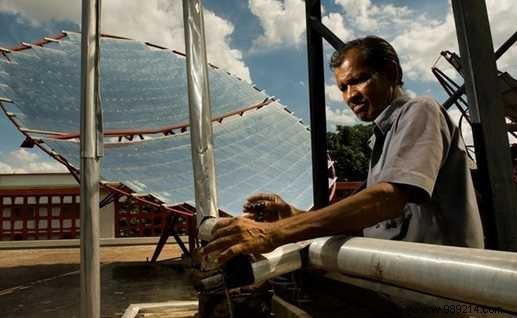
China is building its largest solar power plant.
It will cover more than 2.5 hectares in the Gobi Desert.
It will have the capacity to supply electricity to 1 million households!
Once completed, the new solar power plant will reduce coal consumption by 4.26 million tonnes each year.
This should reduce the still very high levels of air pollution in this country...

But China is not alone in leading the way to clean energy.
It's a global trend. The proof with these 5 most audacious solar projects around the world.
What is your favourite? Tell us in the comments.

This tower looks more like a magnificent bell tower of a lighted cathedral than a solar energy project. Yet this tower can provide electricity for more than 6,000 homes. It is located in Sanlucar la Mayor outside of Seville in Spain.

At Tripolia Hospital in Patna, India, Concentrated Solar Power (CSP) generating systems have been installed. These systems produce steam used to sterilize all medical and laundry equipment.
The hospital also has solar photovoltaic systems to generate electricity for some buildings and for exterior lights. Other solar thermal systems produce hot water for bathing patients and preparing medication.
The various solar systems are also used for the 200 staff members who live on campus, as well as 250 hospitalized patients.

Aeroe is an island south of Denmark known for its use of renewable energy. They use straw combined with solar panels to heat the inhabitants. A third of the island's straw production is used in this way. This represents enough to heat nearly 500 households. The area is also pasture area for cattle.

This autonomous photovoltaic solar power plant produces 100 kWp of energy. It is located in Tangtse, in the Durbuk region of India. Located 4,000 meters above sea level in the Himalayas, the plant supplies electricity to a clinic, a school and 347 homes, for about 5 hours a day.

These photovoltaic panels supply the desalination plant in the village of Kotri, in Rajasthan. The plant produces more than 3,000 liters of drinking water per day from the region's underground saltwater reserves.
Parama, 23, lives above the factory and is one of its biggest supporters. He single-handedly persuaded 100 of the 150 families who use this "soft" water.
He explained to them how the system was environmentally friendly. Like many other villagers, he often had to drink the salty underground water before this solar machine was installed. This installation changed his life!